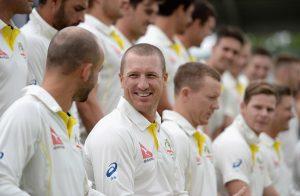Brad Haddin: The epitome of post Ponting Australian era
View : 383
2 Min Read


Brad Haddin: The epitome of post Ponting Australian era: It is not a usual sight when we find 5 key cricketers in a team retiring successively from the international arena, but that’s the current situation with the Australian test team. Ricky Ponting had said that nearly 8 of the players in the touring Ashes squad will never wear the baggy green again; 5 cricketers have hence retired, with Brad Haddin being the latest one to hang his boots.
Brad Haddin is currently in his wrong side of 30s, and is months away from turning 38. So it was just a matter of time before it was meant to happen. But just like his whole career, his retirement was spontaneous, swift and without much of a fuss. A decision which was much anticipated following his refusal to play the 2nd Test against England due to family issues, he retired gracefully considering the circumstances in which he eventually lost his place in the team.
Brad Haddin epitomizes what the post Ponting era has stood for. Forever in the shadows of legendary players, it eventually takes their retirement for some of the talented players to actually make a mark. And Haddin was another victim to the unimaginably talented Australian team of the early 2000s. Making his debut as early as 2001 in ODIs, he never got much of an opportunity into the XI due to Adam Gilchrist. The sheer fitness and consistency of Adam Gilchrist ensured that Haddin could not even get a single chance thereafter to prove himself. But Gilchrist’s retirement opened the doors for Haddin, and he caught the opportunity with both hands.
For a veteran who played about 213 international matches across all the formats, he has about an impressive tally of 473 dismissals to his name, a stuff any wicket keeper would dream about. With 269 dismissals from just 66 Test matches, he ranks 7th in the all time list of most number of dismissals in Tests, and 4th among Australians. Appreciated for his genuine technique as far as wicket keeping is concerned, he fought off competition from the likes of Tim Paine and Matthew Wade quite often to be the no 1 wicket-keeper of Australia.
Haddin was eventually given his Test debut in 2008, against West Indies. Being what can now be considered as a mould of traditional wicket-keepers; Haddin was never the greatest of the batsmen. But that wasn’t an excuse for him to underperform. He has scored about 3266 runs at an average of 33, a healthy average for a wicket-keeper.
As his career progressed, he began to improve his glovework and batting, with his first 50+ score coming in his 16th Test match. And thereafter he never looked back. Chipping in with useful contributions down the order, the highlight of his batting career was the Ashes down under in 2013-14, wherein he scored 463 runs; the highest for a wicketkeeper in Ashes history. Also, he had a record 29 dismissals in the 5 Tests, the most number of dismissals by a wicket-keeper in a Test series.
And the surprising fact was that before the Ashes, Matthew Wade was the preferred keeper, but the selectors decided to give the vice-captaincy mantle and wicket-keeper to Haddin, who worked hard in the domestic circuit post a dry spell in 2012-2013. Though Mitchell Johnson was named as the man of the series, Haddin was the backbone of Australian middle order and a gem of a keeper behind the stumps.
Even in ODIs, he has batted for several positions, particularly the opening position and no 7. He has scored about 3122 runs in his 126 match- career, with both of his centuries coming against the neighbors New Zealand. With a healthy strike rate of 84, he was a decent opener and a finisher for the team, and played his part to the fullest. Even as a wicket-keeper, he has about 187 dismissals to his name, an impressive achievement considering the number of matches he has played.
He was not a man who was devoid of controversies, with the most prominent being a dismissal against Neil Broom in an ODI in 2009. And the circumstances of his final Test series, wherein he decided to support his seriously ill daughter ahead of the team, eventually ended his tour short, as he was not picked again by the management. And not a man who would smart away from voicing out his opinion behind the stumps, thus successfully carrying on the Aussie legacy of sledging which makes them one of the most dangerous opponents to face.
While he might not achieve a status of legend amongst the Australian greats, he will be forever remembered as a key member who helped in a relatively smooth transition following the retirement of Aussie cricketing giants from the Ponting era. And with his retirement, he can finally give the much needed attention to his family, and calls curtains to the Michael Clarke era.
Download Our App